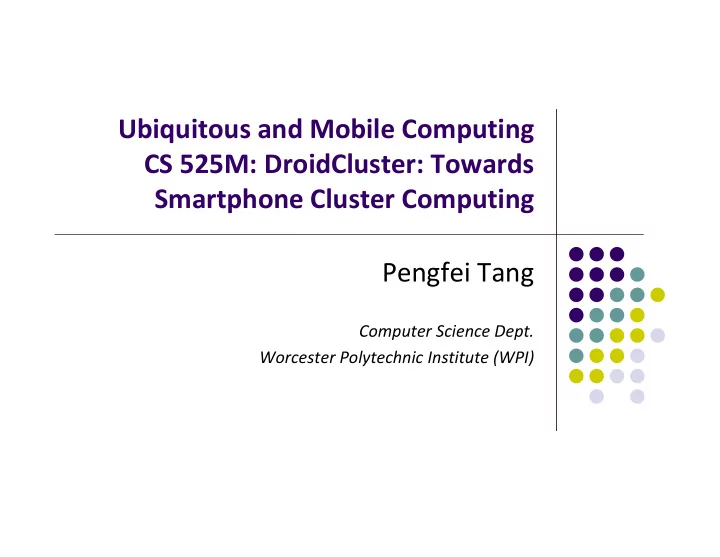

Ubiquitous and Mobile Computing CS 525M: DroidCluster: Towards Smartphone Cluster Computing Pengfei Tang Computer Science Dept. Worcester Polytechnic Institute (WPI)
Introduction: Cloud computing are well ‐ known and frequently investigated topics Plenty of research work during the past 30 years there is still recent and ongoing work in this area on big data like Hadoop
Introduction/Motivation: Why is smartphone cluster computing important? In mobile computing, miniaturization and energy saving are obviously a trend Yesterday’s clustered workstations could compute climate models or simulate nuclear explosions, clusters of today’s smartphones could do so as well Volunteer computing is a viable alternative to buying or renting big compute clusters on many successful scientific projects like Seti@home , Einstein@home
Introduction/Motivation: what will be learned? Some scenarios where it is reasonable to use the computational resources of mobile devices overview about the current state and development of technology for mobile computing a feasibility study, implementing and evaluating a small MPI cluster using ordinary Android mobile phones
Applications Rolling Clouds Corporate Environments Cooperative Cracking
Rolling Clouds Mobile devices can easily form a closely coupled computing cloud WiFi infrastructure already built into modern trains for providing with internet access Benefit: Fine gained local weater forecast and ozone concentration
Corporate Environments Distcc is a distributed compiler framework for speeding up compilation of source code
Cooperative Cracking Moxie Marlinspikes tool WPACracker uses a 400 CPU cluster running in the Amazon cloud At Black Hat DC 2011, Thomas Roth successfully demonstrated another Cloud Cracking Suite (CCS) that is able to crack WPA ‐ encryption in a reasonable time Large number of smartphones share their resources and coordinate a distributed attack lower the time
Mobile computing hardware evolution
Mobile computing hardware evolution
Mobile computing hardware evolution Changes in performance reflect the rapid architectureal innovations that we can currently witness in the mobile SoC market the computing power available in small mobil devices already surpassed the computing power of high ‐ end workstations from a few years ago
Feasibility study Build a small cluster with 6 Android nodes(LG P500) Each phone equipped with a 600MHz MSM7227 processor and 512MB RAM To distribute the calculation, using a LINPACK implementation based on a MPI library MPI: Message Passing Interface is a standard describing the message exchange in parallel computations in distributed systems. LINPACK: software used to measure a system’s floating point computing power. Now, it is the standard benchmark for the TOP500 list.
Feasibility study
Feasibility study
Conclusions/Future Work The current evolution in mobile computing platforms is at a faster pace and follows the developments in the desktop world. In order to pursue the highest performance, mobile computing platform are formed between mobile and desktop. This combination leads to conclude that we should find ways to fully utilize these computational capacities
Conclusions/Future Work It is possible to integrate Android devices into a distributed cluster in a way does not interfere with the running Android system and apps. Distributed computing frameworks better adapted to the special challenges in the mobile computing world will be developed A bunch of mobile devices replace a stationary server will be a real benefit in an environmental as well as in a cost sense
Thanks. Questions?
Recommend
More recommend